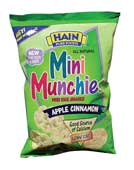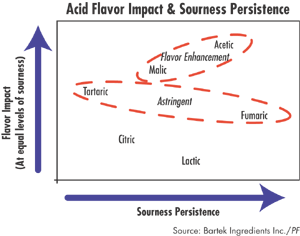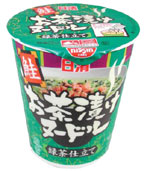
“Meating” Microbial Challenges
Americans generally assume the foods they purchase are safe to eat, and so they should. A foodborne illness is far more likely from foods cooked at home or consumed at a potluck “church social” than from foods manufactured in commercial facilities.Deli meats in sandwiches often go unrefrigerated until lunchtime or on deli platters left for hours at room temperature. In these products, as in many others, formulators long have relied on acidifiers to control microbes.
As a product's pH is lowered, the amount of an organic acid in its undissociated form increases. The undissociated forms have the greatest ability to keep microbial growth under control. Some organic acids, such as benzoic and sorbic acid, are extremely effective microbial inhibitors and are considered “preservatives.”
Other acids (or their salt forms), whether directly added or the result of beneficial microbial fermentation, enhance flavor and reduce spoilage. Lactic acid (sodium lactate) and acetic acid (sodium diacetate) are examples. Studies have looked at the impact of Listeria inhibition in RTE luncheon meat with 2.2% salt, 0.1% sodium diacetate and various levels of potassium lactate. (See Powerpoint presentation on website below.)
Since January of 2002, Mintel International's (Chicago) Global New Products Database (GNPD) lists 22 new processed meat, fish and poultry items in North America with “sodium diacetate” on their label.
For example, Tyson Foods (Springdale, Ark.) is currently launching 31 new deli meats into the self-service deli section at supermarkets nationwide. “The line includes cuts of chicken, beef, ham and turkey. The launch is part of a company effort to grow into other meat categories besides chicken,” notes the GNPD.
Several chicken products, however, are being introduced, including Honey Roasted Chicken Breast, Smoked Chicken Breast, Rotisserie Flavor Chicken Breast and Oven Roasted Chicken Breast (shown here). The product notes the presence of both sodium lactate and sodium diacetate. A 5.5-oz. package is available in supermarkets for $2.50.
www.kraft.com/newsroom/05012001a.html
—USDA's approval of sodium and potassium lactate and sodium diacetate in RTE meats
www.meatami.com/content/TradeShow/ConferenceMaterials/Milkowski.ppt
— Powerpoint presentation on Listeria control
www.PreparedFoods.com/archives/1999/9908/9908delimeats.htm
—Acidifiers in meats
www.PreparedFoods.com/archives/2002/2002_6/0602meats.htm
— Acidifiers for microbial control

Lower pH, Less Bite
Although a decreased pH is often a formulation goal—for reasons ranging from microbial control to leavening—the accompanying increase in acid bite may not be desired. Glucono-delta-lactone (GDL) is known particularly for its ability to lower pH with minimal impact on taste.
A quick search of Mintel's GNPD turns up 32 records of new foods and beverages that contain GDL, introduced in North America since January 2001. Examples include baked goods such as Gluten-Free Corn Breads from Glutino (Laval, Quebec) and Soda Shoppe branded Coconut Cream Pie from Mrs. Smith's Bakeries (Norcross, Ga.), which also contains calcium gluconate. Red Baron Pizzeria Style Four-Cheese Pizza from Schwan's Consumer Brands (Bloomington, Minn.) lists GDL as an ingredient in its crust.

GDL also is popular in refrigerated deli salads that depend heavily on reduced pH for a longer shelf life. The ingredient plays a similar role in Old Home Foods' (Rochester, Minn.) new refrigerated Crab Dip. The lower the pH, the more effective sodium benzoate is as an antimicrobial preservative.

www.omri.org/GDL.pdf —The Organic Material Review Institute of GDL for the National List
www.accessdata.fda.gov/scripts/cdrh/cfdocs/cfcfr/ CFRSearch.cfm?FR=184.1318
—GDL in the FDA's Code of Federal Regulations

Fuze Flavors
Depending on the ingredient and the product matrix into which it is placed, acidifiers have the ability to enhance, mask and contribute to flavor profiles. Balancing a product's sweetness and sourness throughout a taste experience is important. (See chart.) Acids differ in terms of how long sourness lingers.“In applications with aspartame, sucralose, and neotame, all of which have prolonged sweetness, malic or lactic acid is best since they also have a more persistent sourness,” says Sortwell.
A new Tropical Punch Slenderize drink in 18-fl. oz. bottles from Fuze Beverage (Englewood, N.J.) may benefit from malic acid's unique flavor blending property. The product is described as an “extremely unique and effective diet drink” that has only 10 calories, is sugar-free and contains no aspartame. However, it does contain pineapple and mango juice concentrate, natural flavors, Garcinia cambogia rind and dragonfruit extract, L-carnitine and chromium polynicotinate, as well as malic acid. In this case, the malic acid helps blend together discordant flavor notes to achieve a more rounded flavor profile. “We have blended the best of the tropical fruits to create a smooth punch with a little zingy bite," notes the company.
www.PreparedFoods.com/archives/2002/2002_9/ 0902citric.htm—Use of citric and lactic acid in new products
www.PreparedFoods.com /archives/2002/2002_9/ 0902rd_acid.htm—Use of acidifiers for enhancing flavors
www.fuzebev.com —Fuze Beverage

Buffered Beverage for the Buff
A mix of acids (citric, malic and ascorbic) and the salts of acids (calcium and magnesium lactate, zinc gluconate and sodium citrate) serve to fortify and buffer a high-calcium, Strawberry-Kiwi drink introduced a few years ago under the Optimize brand from Pharmative's Nature Made Nutritional Products (Mission Hills, Calif.).
The calcium and magnesium lactate provides “bone building” 500mg calcium and 100mg magnesium per serving. Additionally, the company's website points out the product's 5g inulin and 400 I.U. of vitamin D3 increase absorption; the 4mg zinc offsets imbalances in calcium; 130mg phosphorus “deposits on bone, giving bones and teeth their rigidity.” The 250mg vitamin C (a.k.a. ascorbic acid) helps the body to utilize absorbed calcium and maintain normal calcium crystals in bones.

www.optimizenutrition.com/hi.calcium/hi.calcium.html
—Optimize Hi-Calcium product description
www.nestleusa.com —Nestle USA
Some of the information in this article was derived from Mintel International's Global New Products Database, www.gnpd.com, 312-932-0400. For more information on the GNPD, e-mail kthackston@mintel.com

Sidebar: Going Global
A search through Mintel's GNPD turns up acidifiers in some of the most interesting products these days.
A distinctly Japanese product, Salmon Noodles in Green Tea soup is being introduced by Nissin Foods Products (Osaka, Japan). The savory concoction includes flavored components such as hydrolyzed protein, soy and fish sauce, as well as various extracts (chicken, kombu seaweed, green tea, shiitake mushroom and bonito). The translated ingredient statement lists both the terms “acidifiers” and “alkalies.”



 Claudia Dziuk O'Donnell is Chief Editor and Associate Publisher of Prepared Foods magazine including its NutraSolutions and Culinary sections. Her responsibilities include determining the editorial content of the print publication and the New Products Conference.
Claudia Dziuk O'Donnell is Chief Editor and Associate Publisher of Prepared Foods magazine including its NutraSolutions and Culinary sections. Her responsibilities include determining the editorial content of the print publication and the New Products Conference.